With the appearance of iOS 4.0 Apple introduced a new Test-Framework for automatically UI Testing: UI Automation. Based on Javascript and build-in into Instruments, UI Automation is a very useful tool during the Developing of iOS Application.
A very good introduction in UIAutomation is here and here.
During the development of a iOS Application, we decided to port it to iOS 4.0 and therefor use also UIAutomation for regression testing (before that we used GHUnit Tests for Component Testing – but thats another story).
As we are primarily a company dealing with web-based application, we had almost zero afford to deal with the Javascript syntax of UI Automation. But we had to deal with the fact, that we developing a dual language Application (de and en), and therefore need a possibility to test the whole UI in both languages.
If you are familiar with UI Automation, you probably know that the Framework uses the accessibility labels of your UI and also often Button Labels. So you have to deal with the actual language of the current UI Setting. But wait. There is already a valid mapping of different language to a given key. If you internationalize your application you will use so called Localizable.strings to do your language Mapping (more here).
So we just need a way to move our already existing Mapping into our UI Automation world. UI Automation supports the import of separate JavaScript Files to use your own Libraries and Settings. So i build a conversation script to translate your different Localizable.strings to JavaScript and moving all languages into one big collection.
So for example a String like this:
"Library" = "Bibliothek";
"Shop" = "Kiosk";
Will be converted to:
UIA.Localizables = {
"de":{
...
"Library" : "Bibliothek",
"Shop" : "Kiosk",
...
},
"English":{
}
...
}
The next step is to determine during your UIAutomation Test which language Setting you need to Load from your Localization File.
It is possible to readout some System Settings during an UIAutomation Test. The basic functions to find your current language and to read the correct language Array look like this:
UIA.getCurrentLang = function(){
if(application.preferencesValueForKey("AppleLanguages")[0] == "en")
return "English";
else
return application.preferencesValueForKey("AppleLanguages")[0];
}
UIA.getCurrentLocalizables = function(){
return UIA.Localizables[UIA.getCurrentLang()];
}
var Localizable = UIA.getCurrentLocalizables();
The first function is necessary to capture a quirk of the recent Xcode Versions (some people calling it a bug 🙂 ).
So now we can just use our String within our Test-Cases.
#import "lib/Localizables.js"
function delay(seconds){
UIATarget.localTarget().delay(seconds);
}
function tapTab(name){
var window = UIATarget.localTarget().frontMostApp().mainWindow();
window.tabBar().buttons()[name].tap();
}
var window = UIATarget.localTarget().frontMostApp().mainWindow();
tapTab(Localizable['Library']);
delay(1);
tapTab(Localizable['Shop']);
delay(7);
I attached the conversion script to this post.
You just need to alter the source and destination folders of your i18n files and the UIAutomation-Tests directory.
Download file


